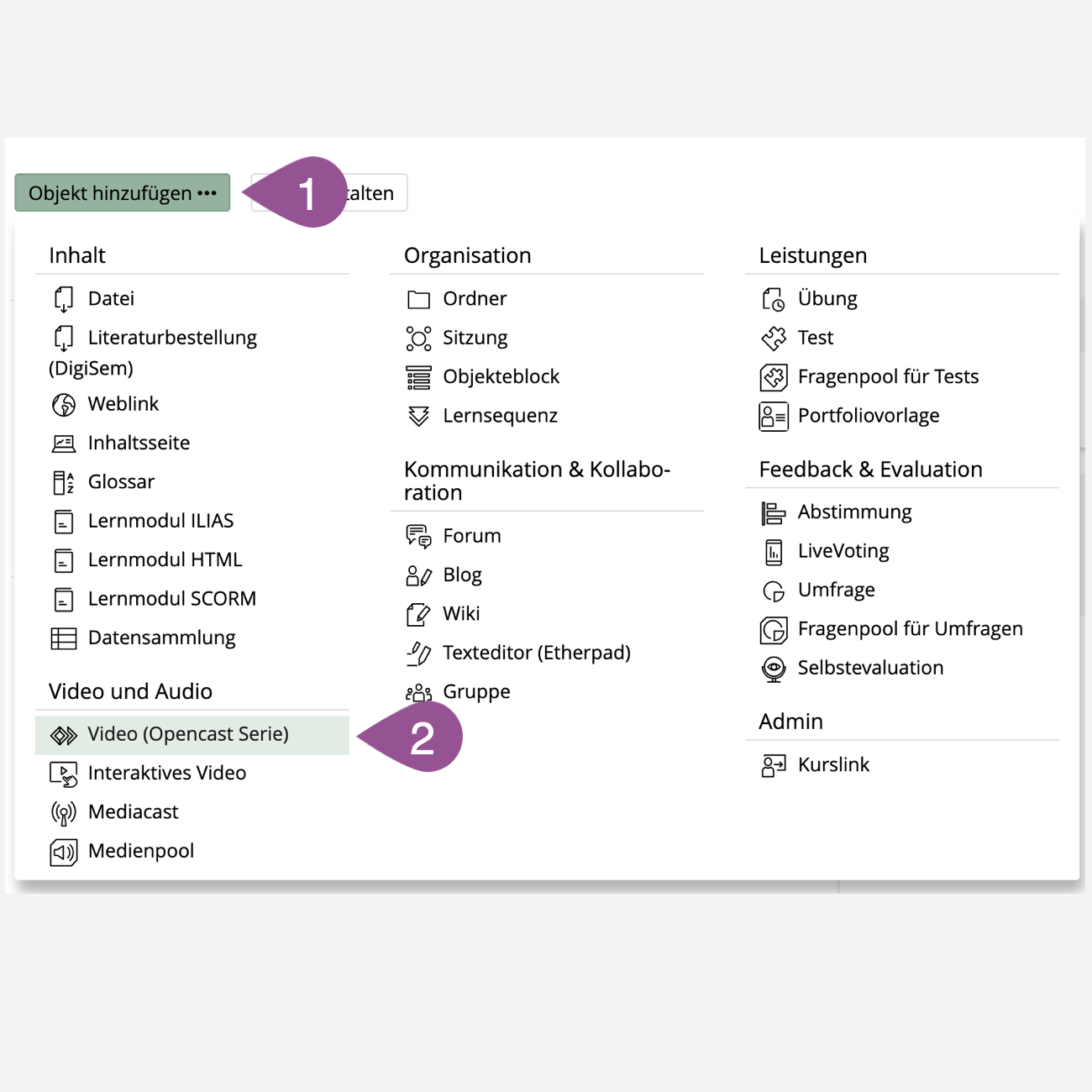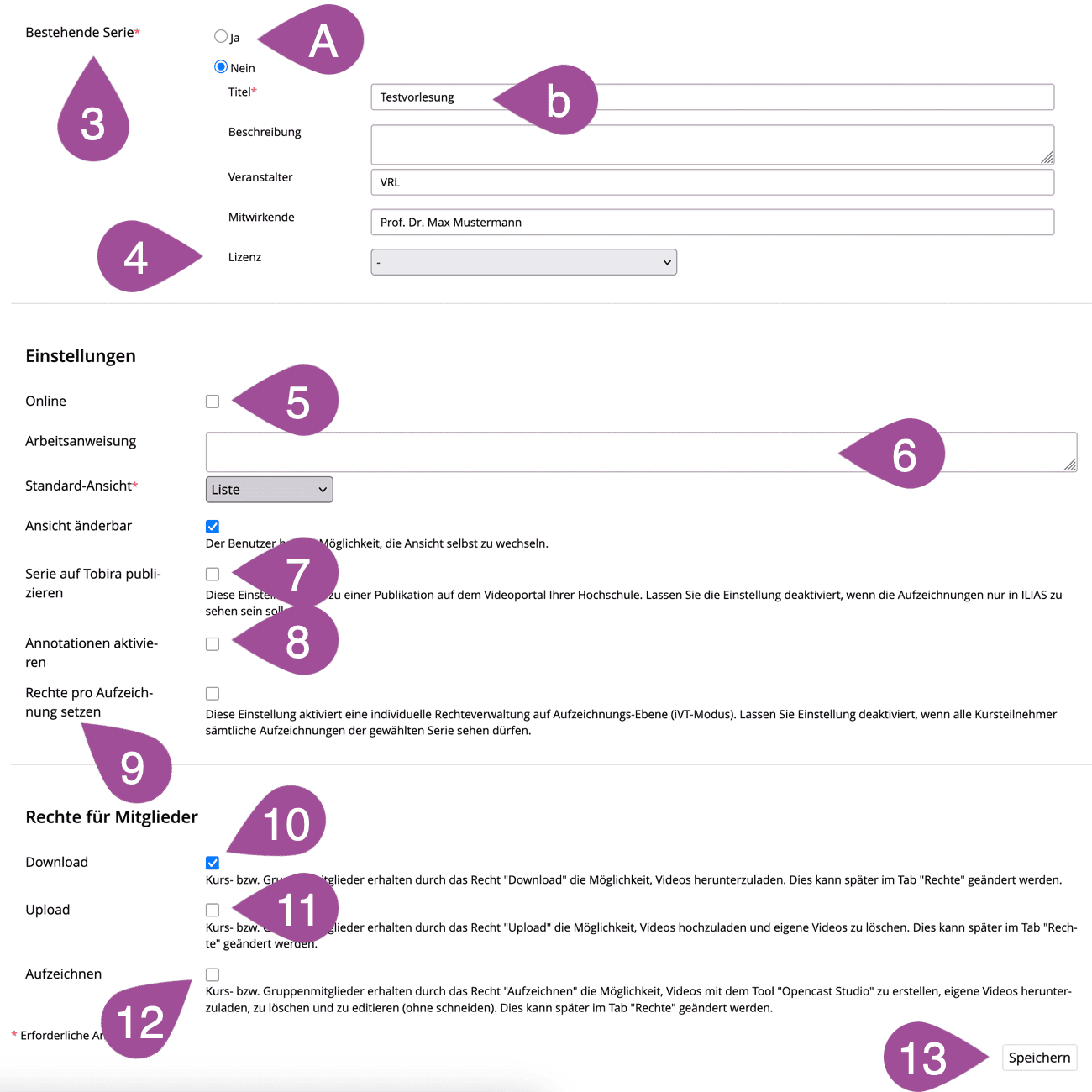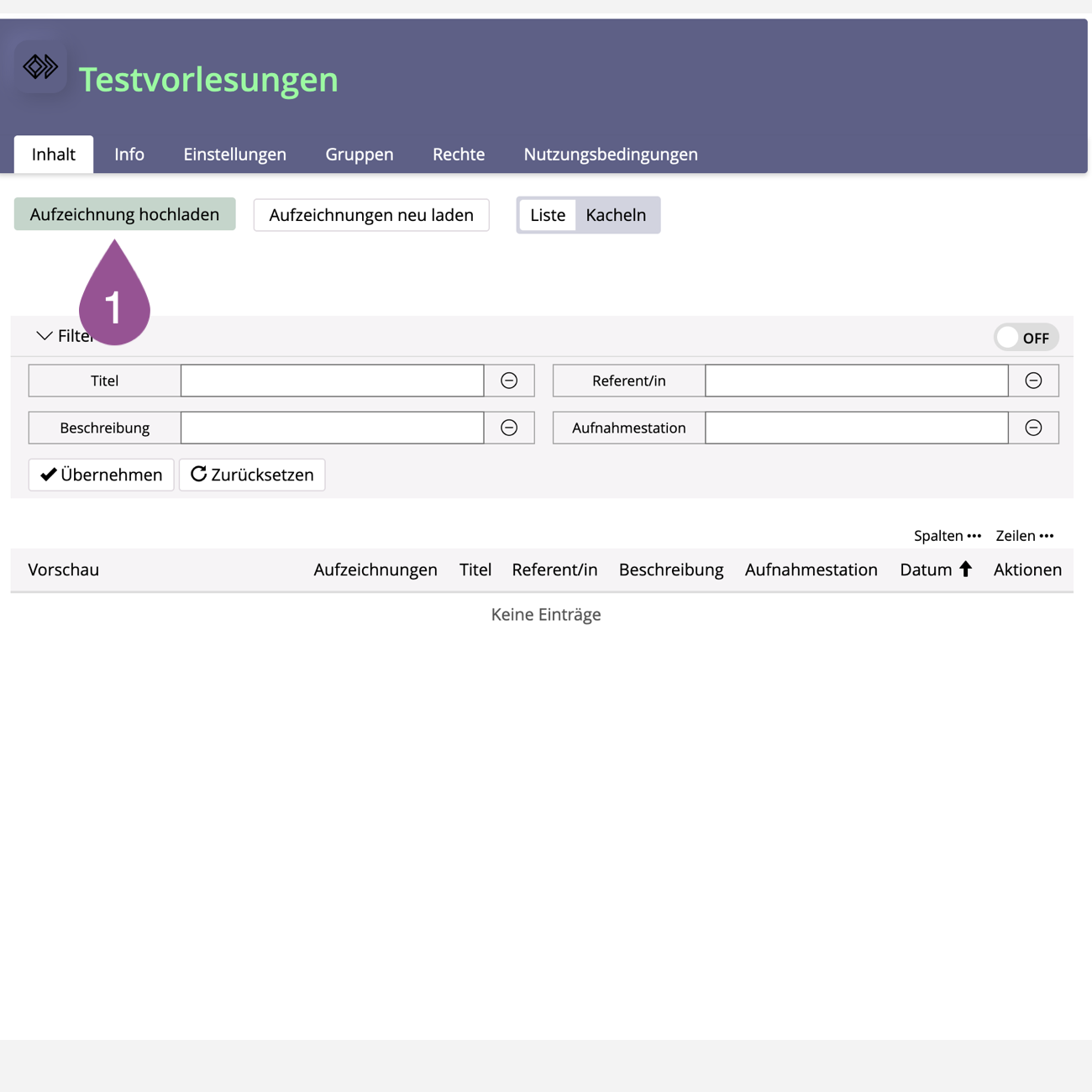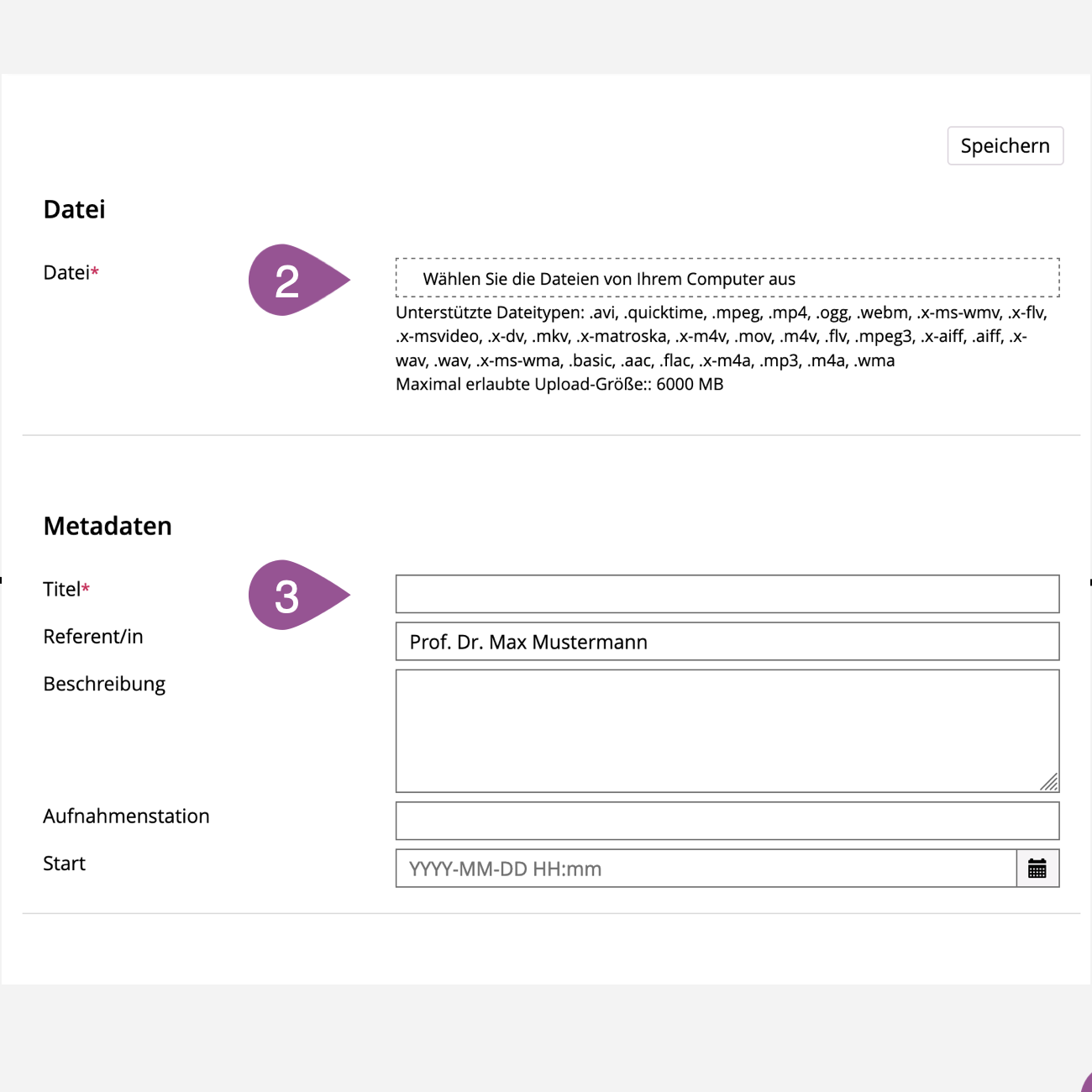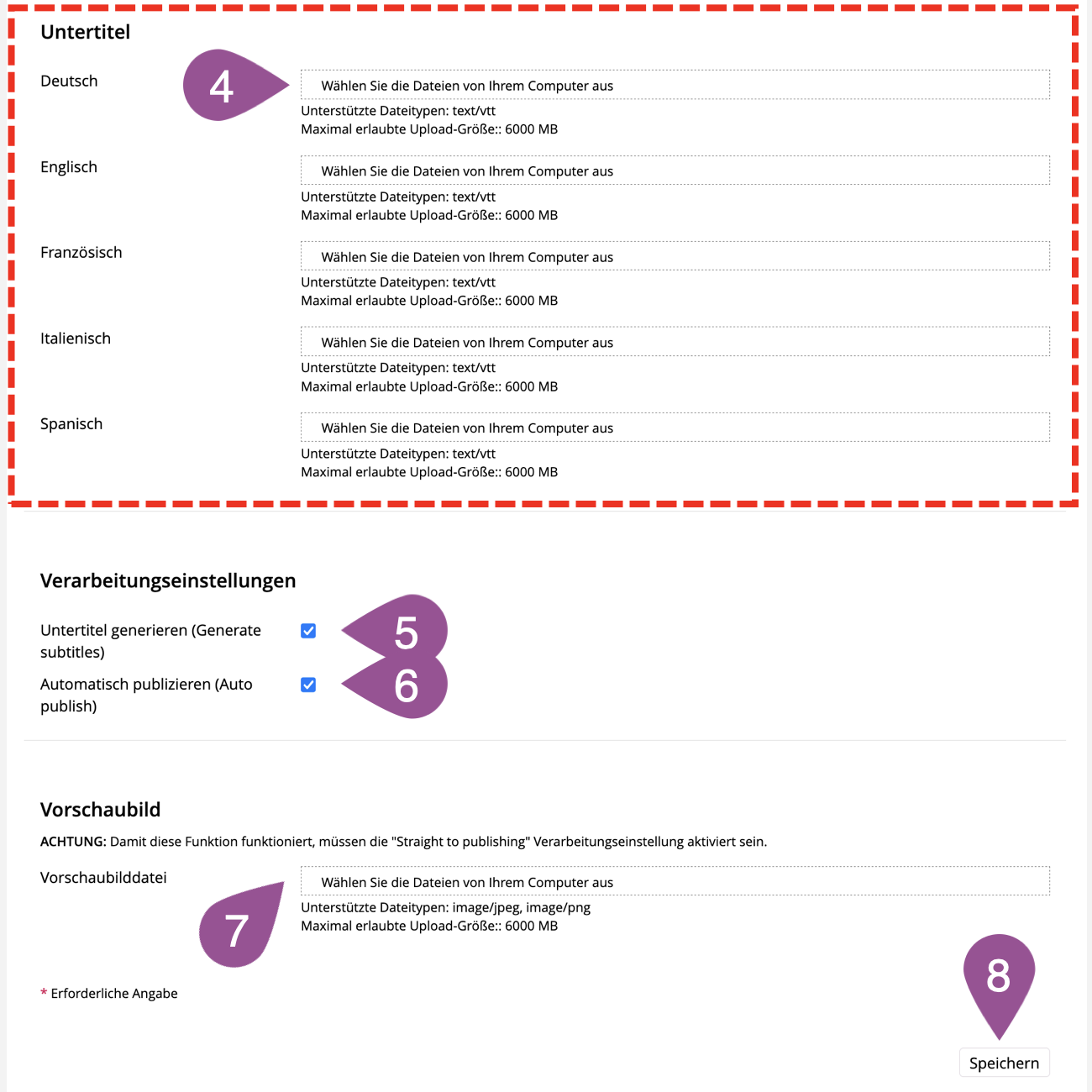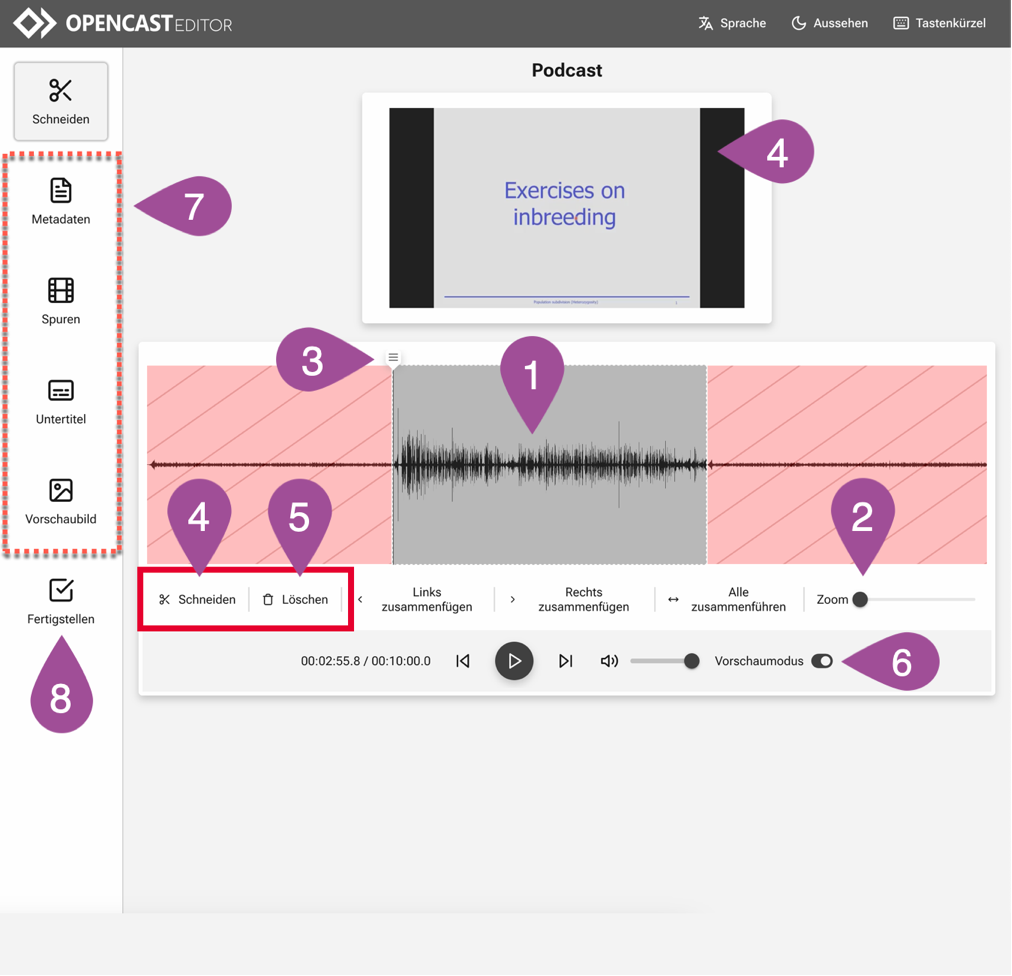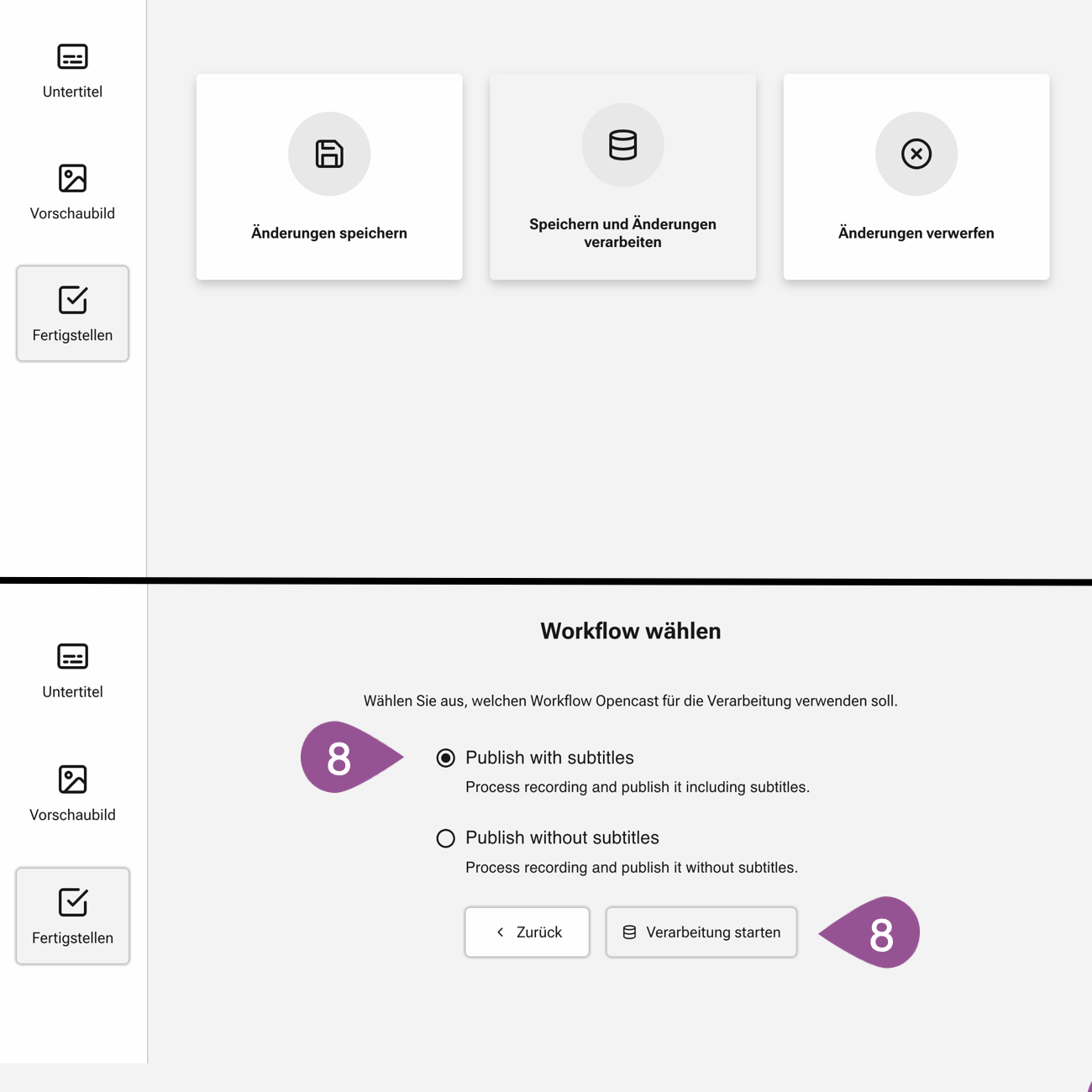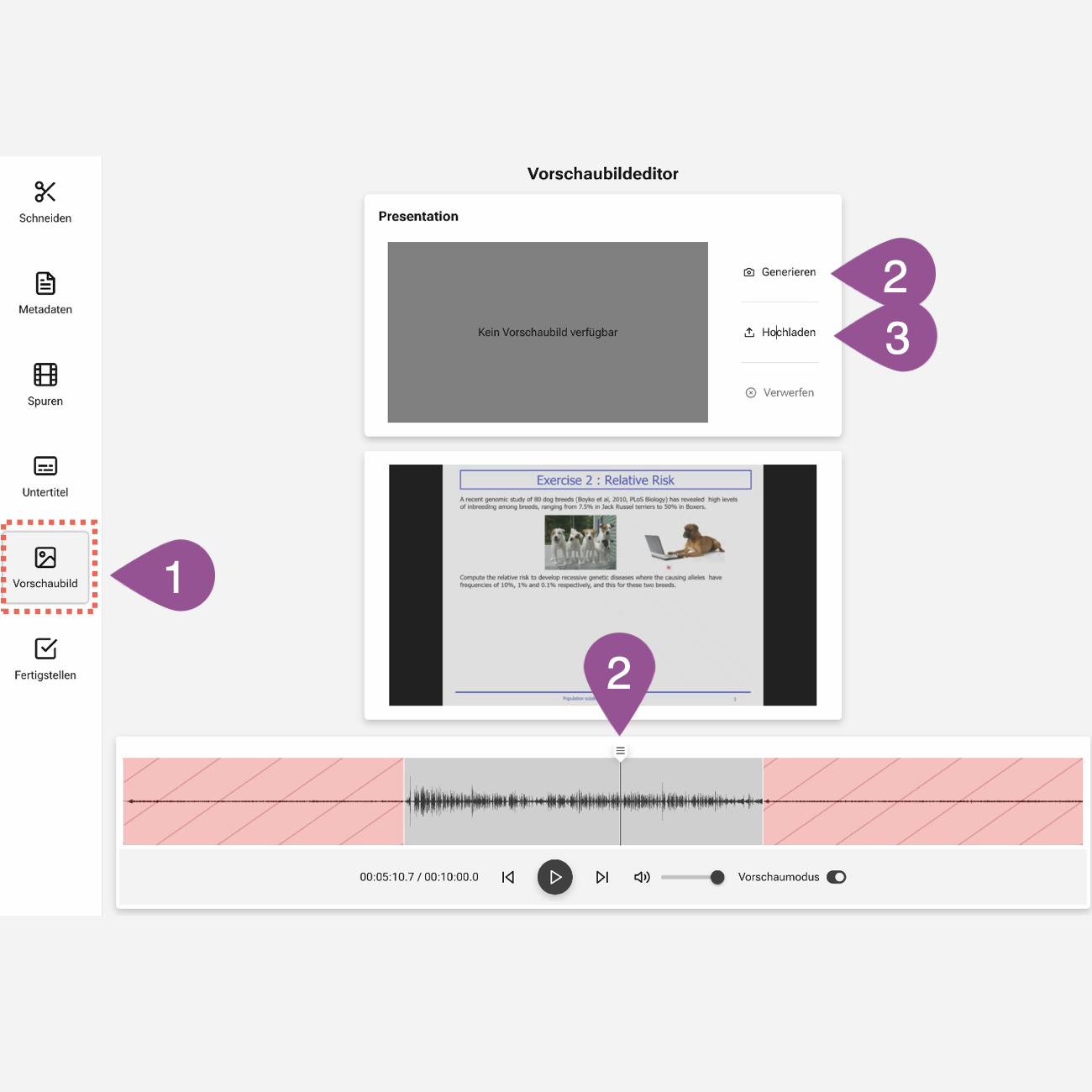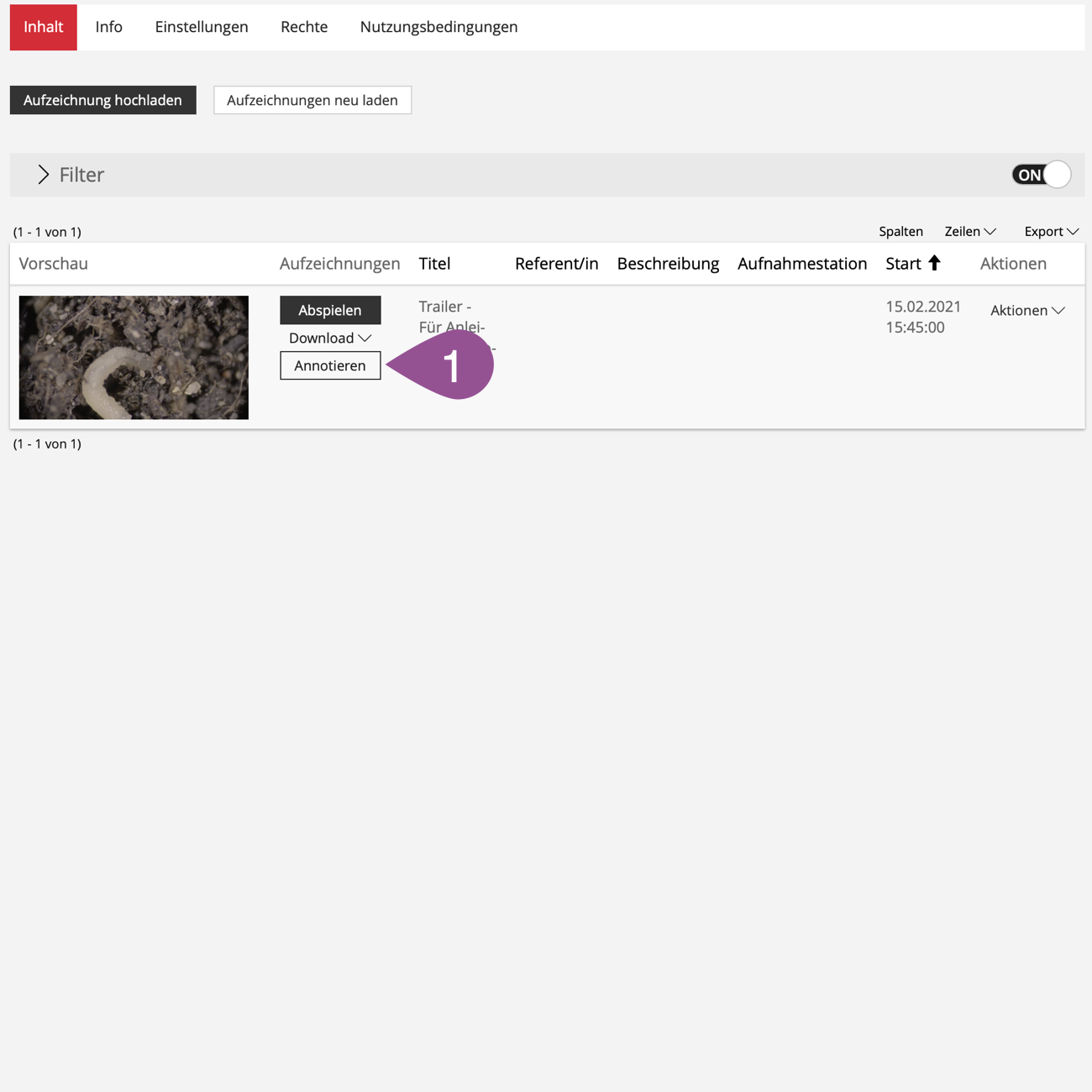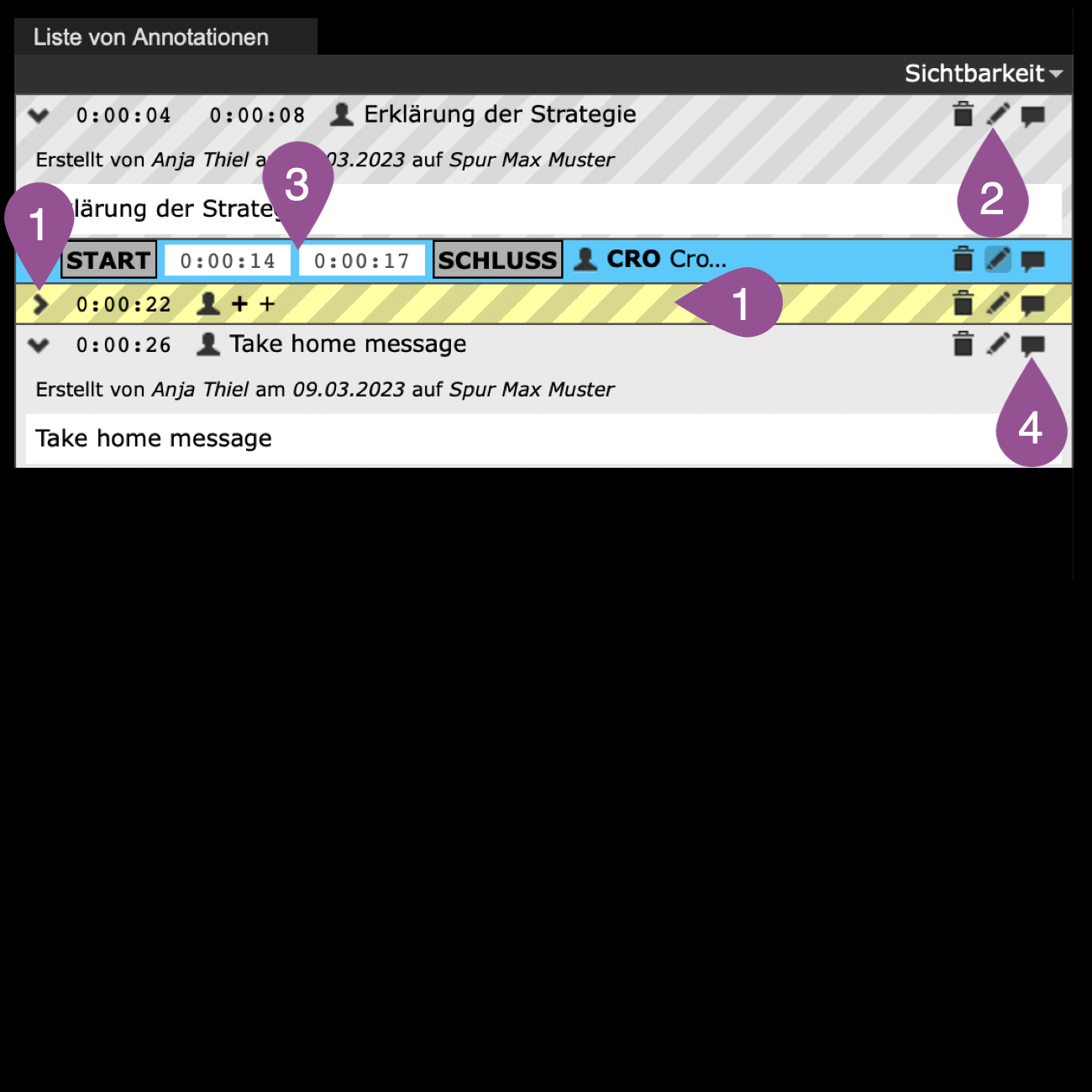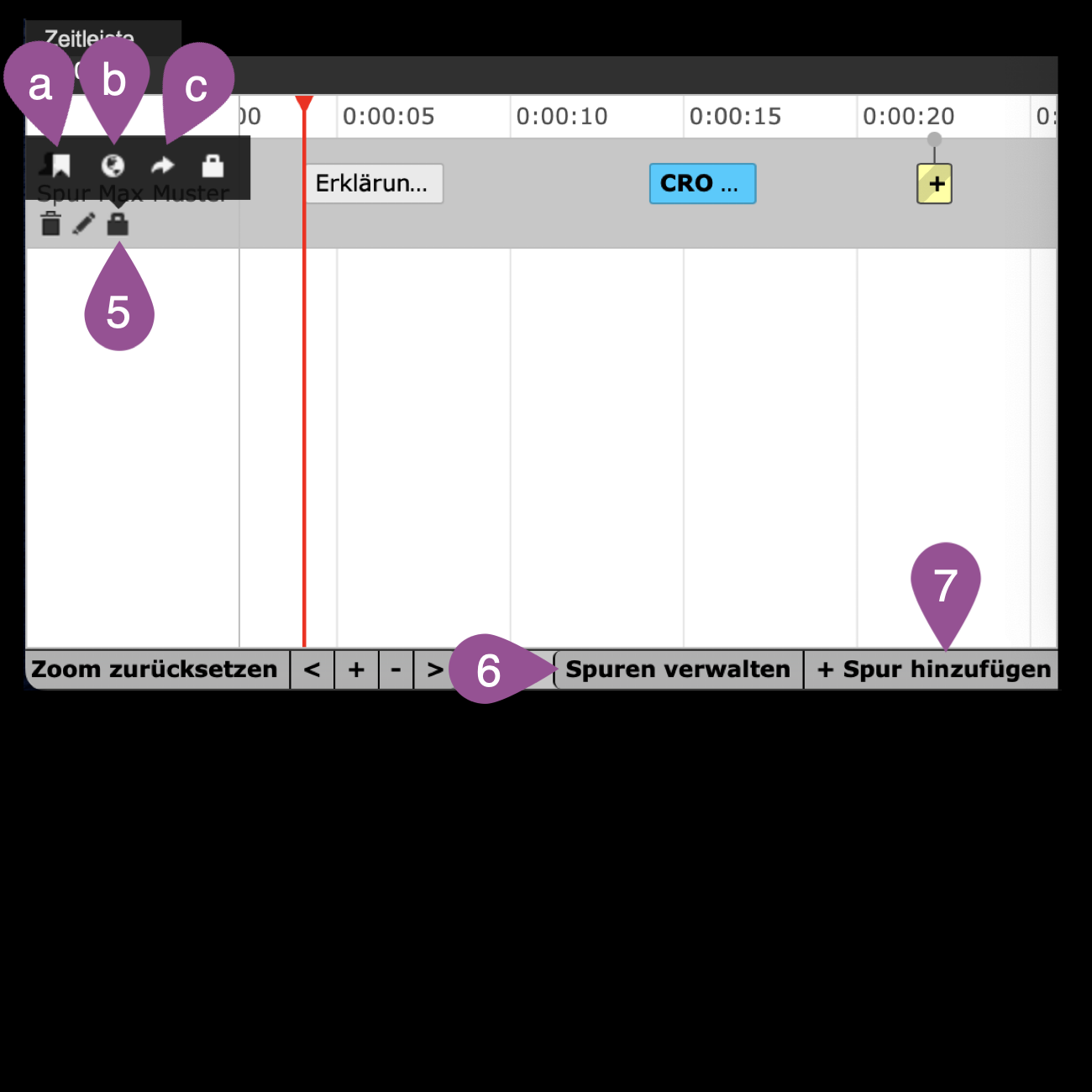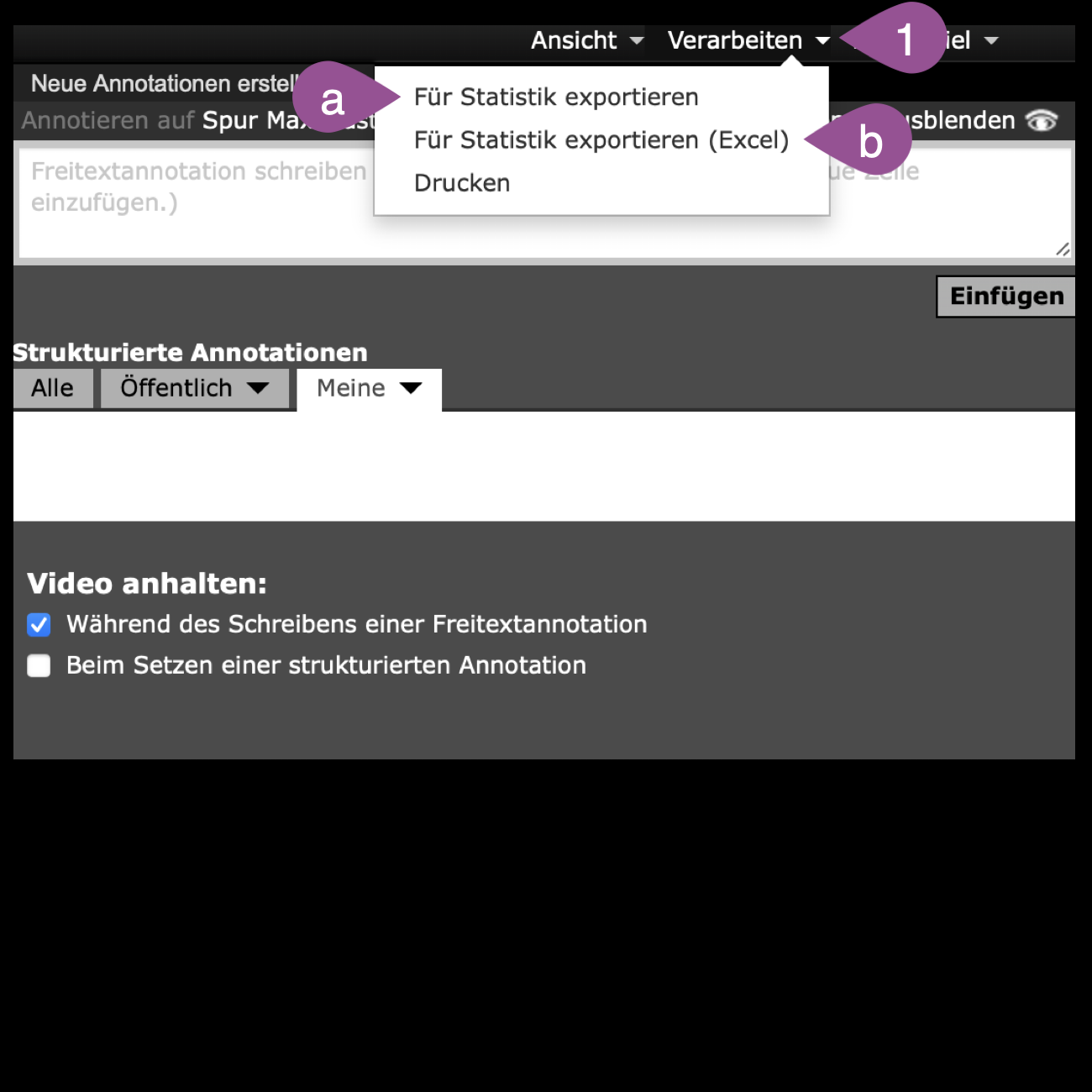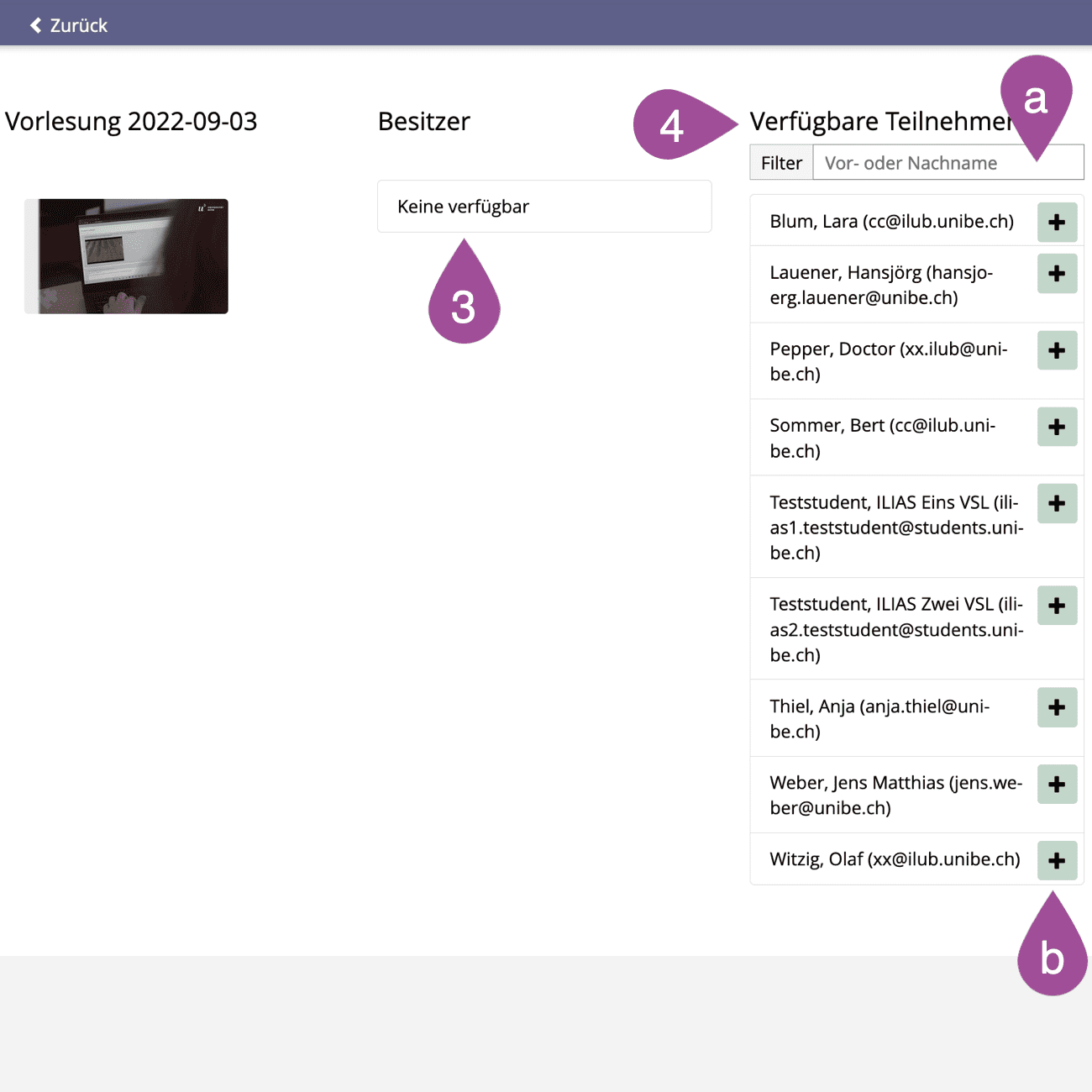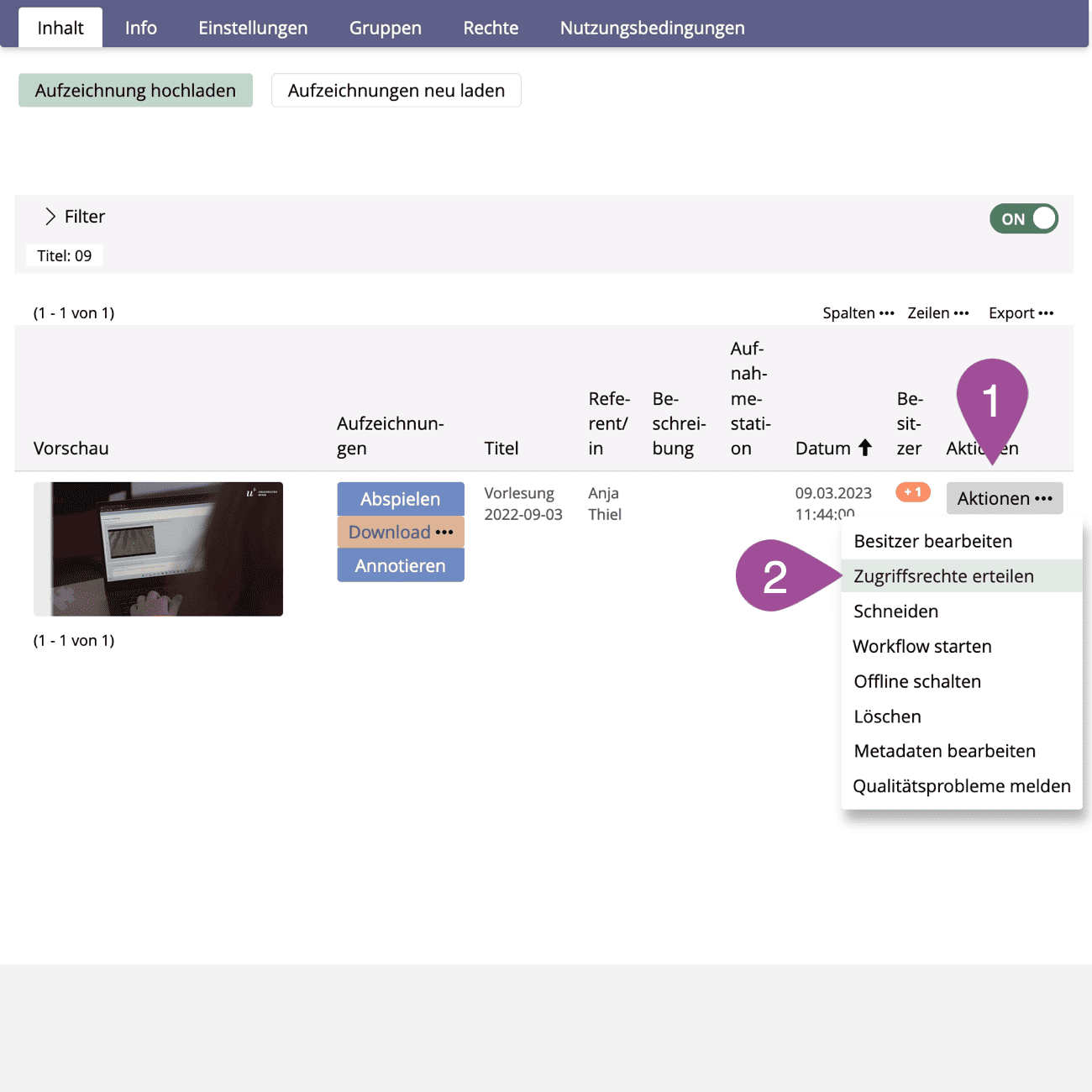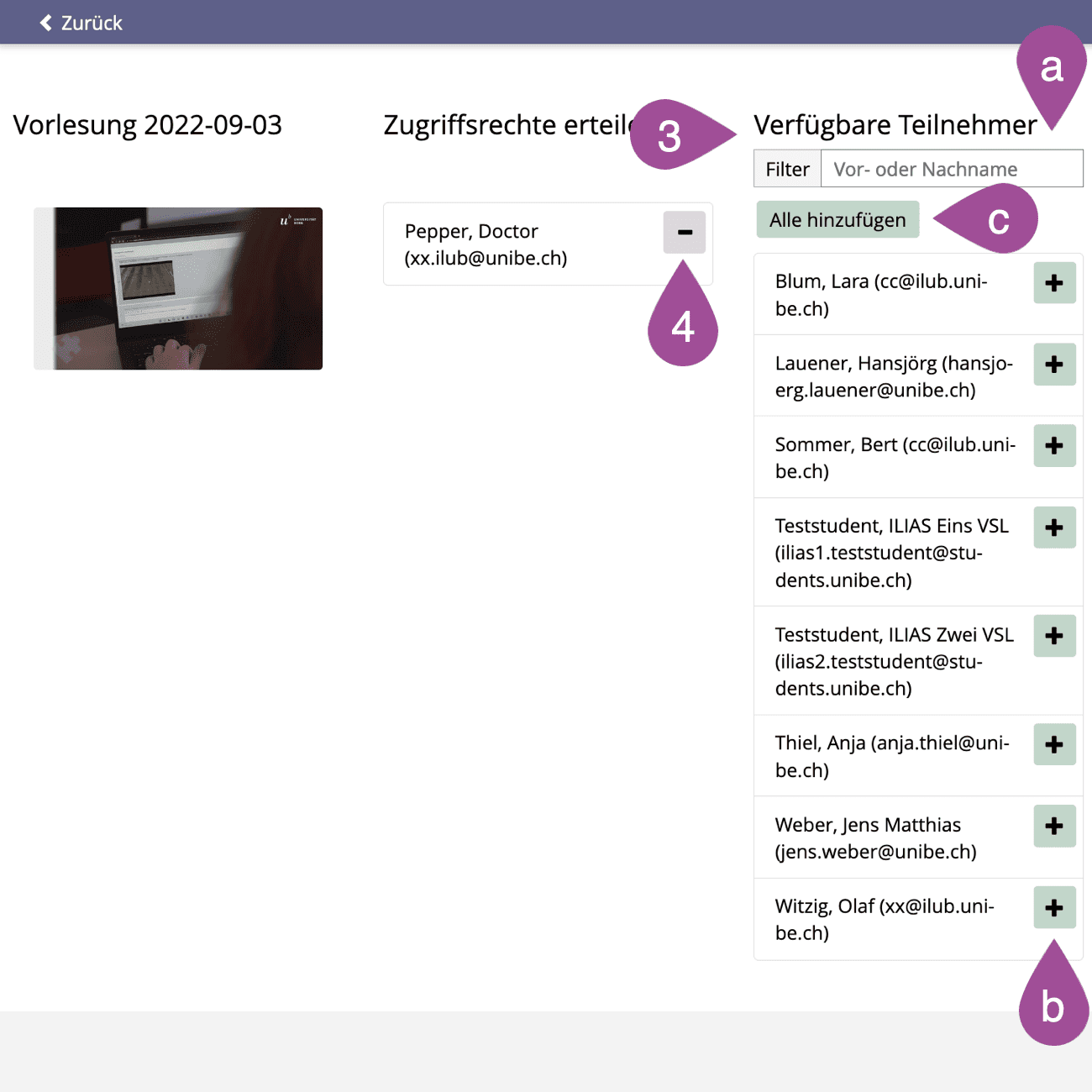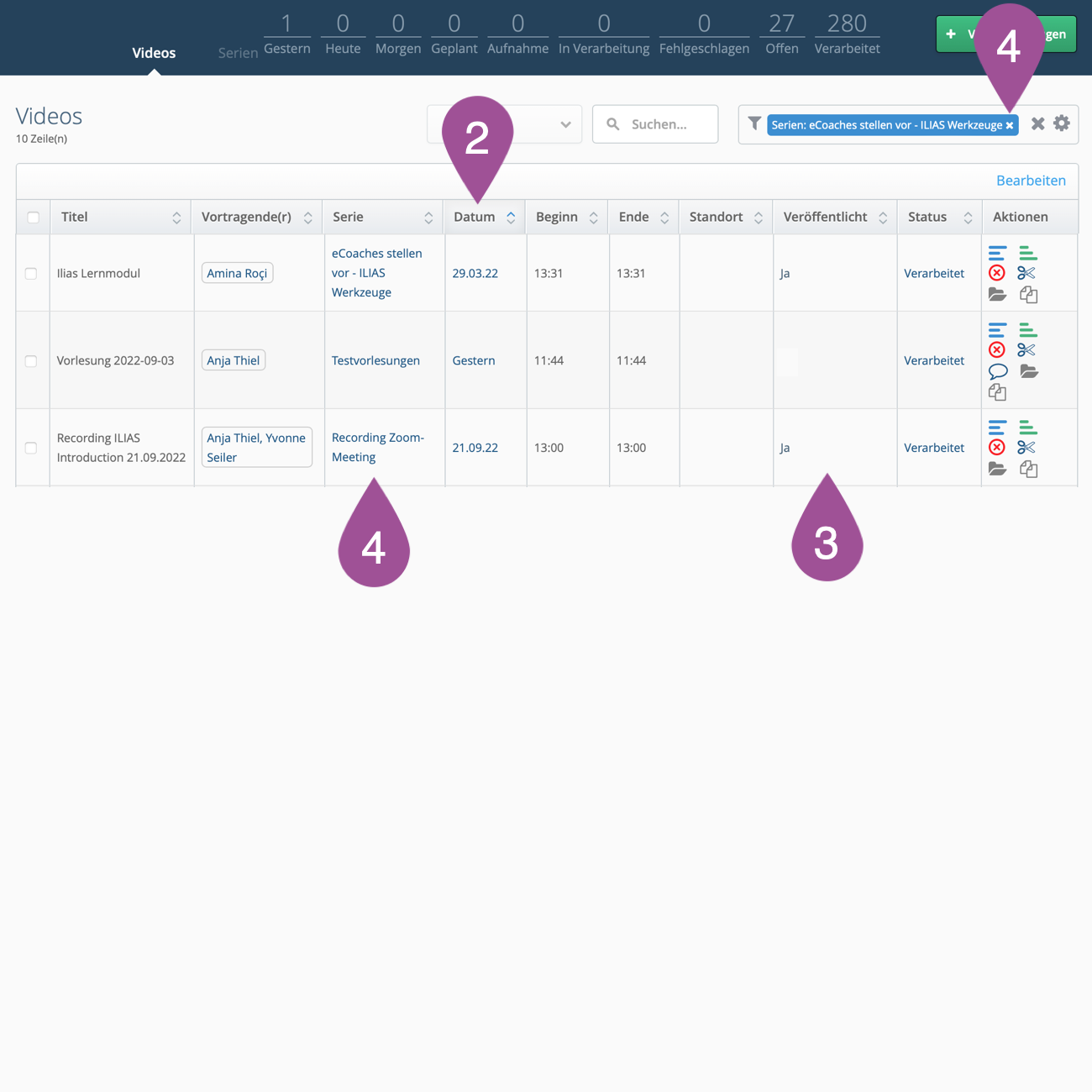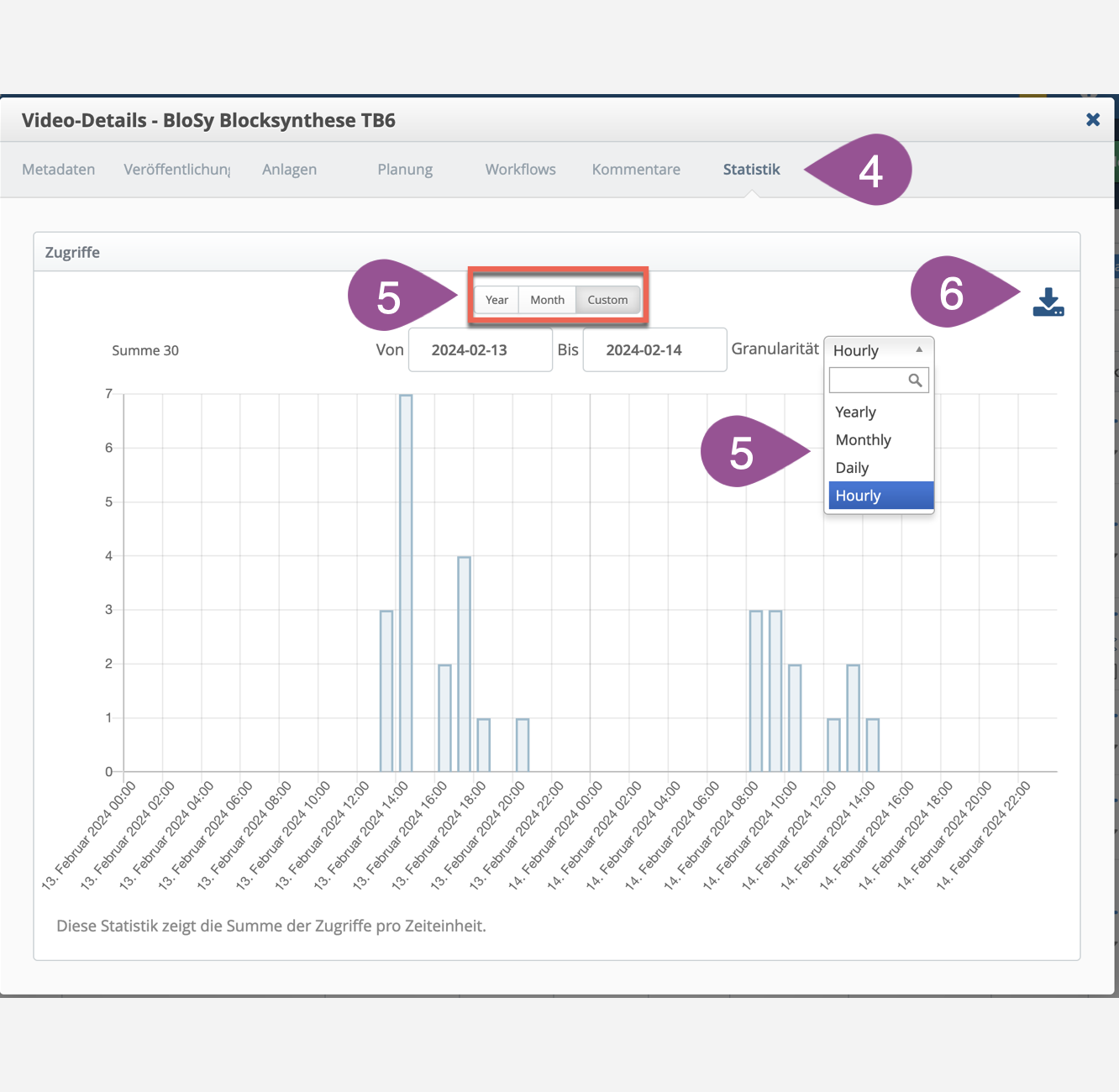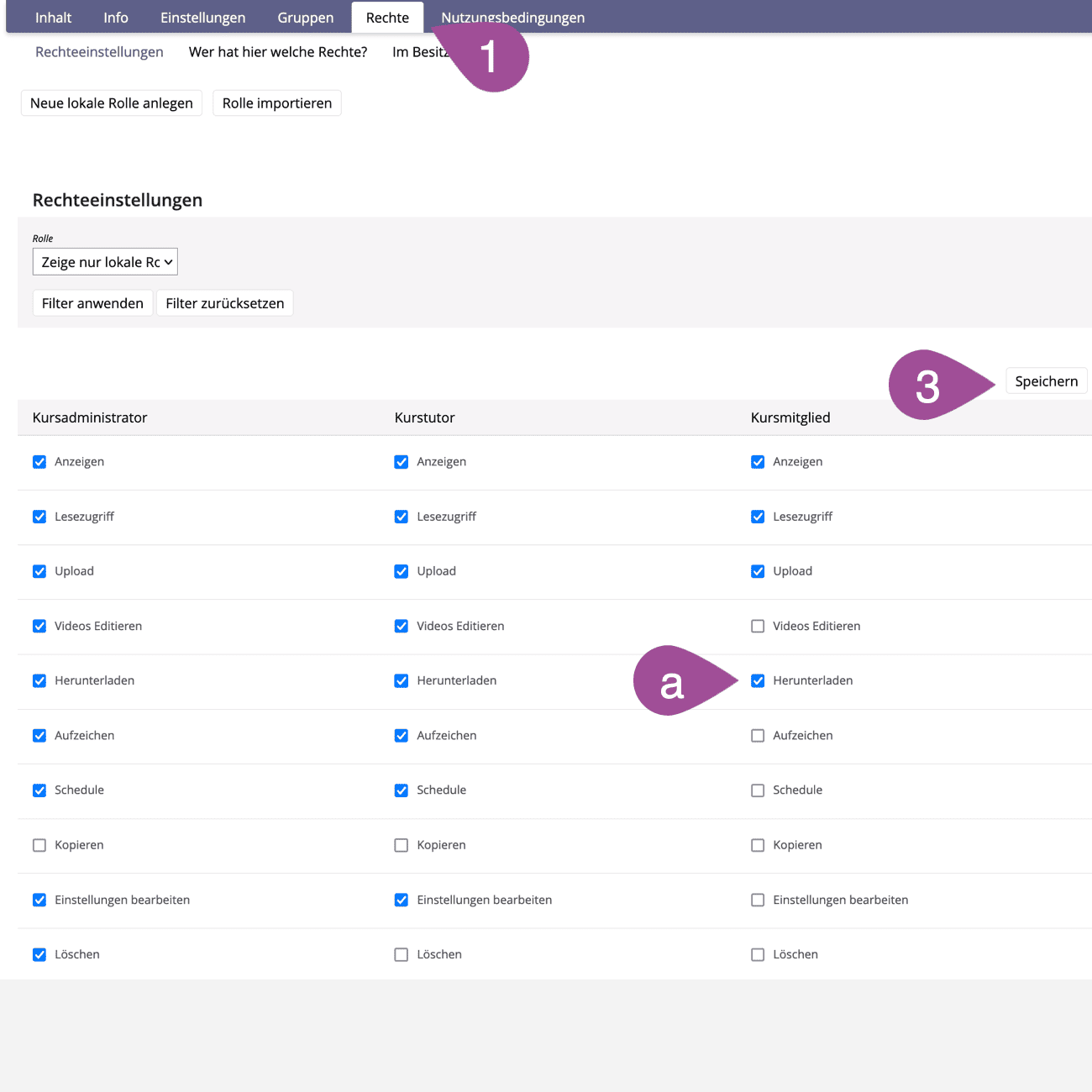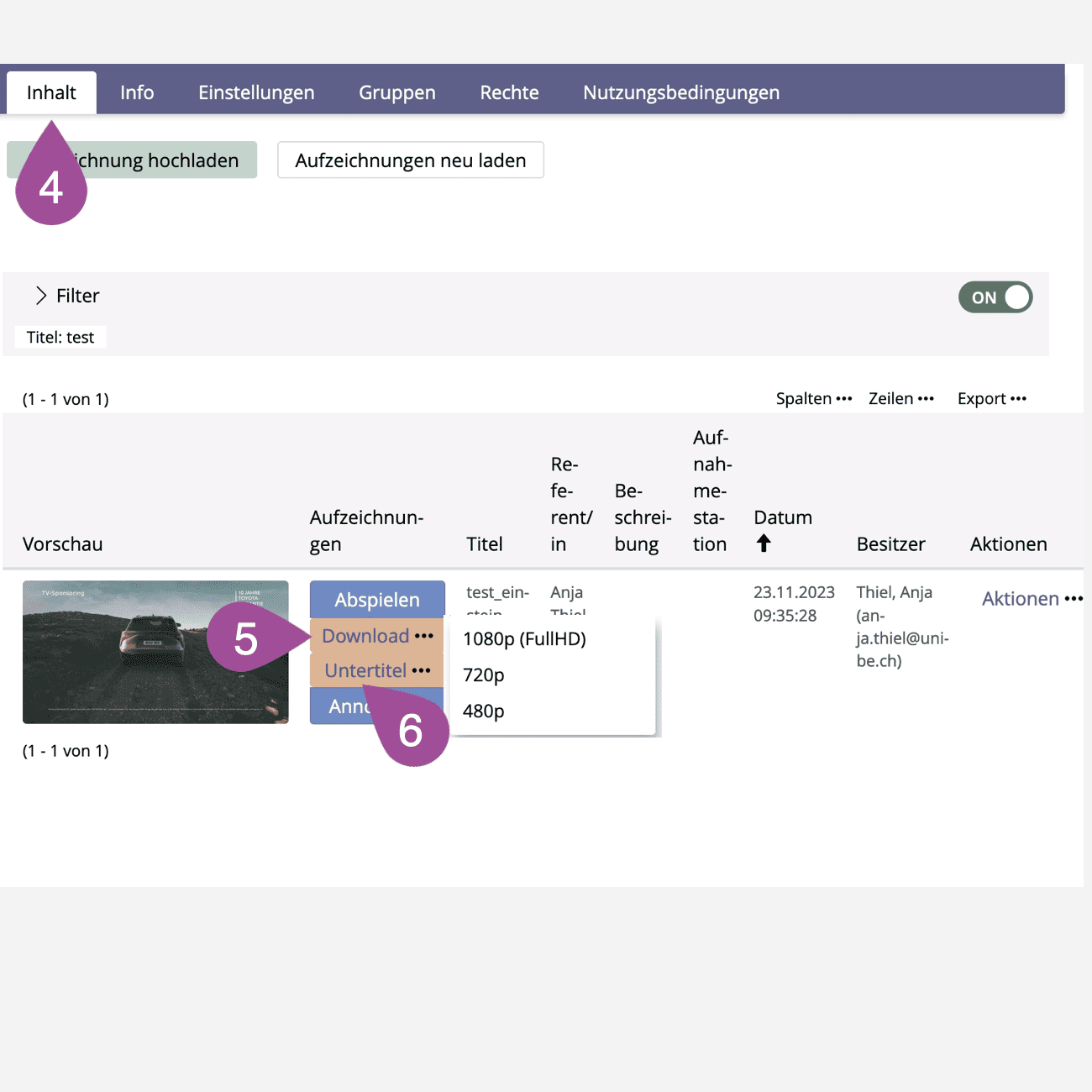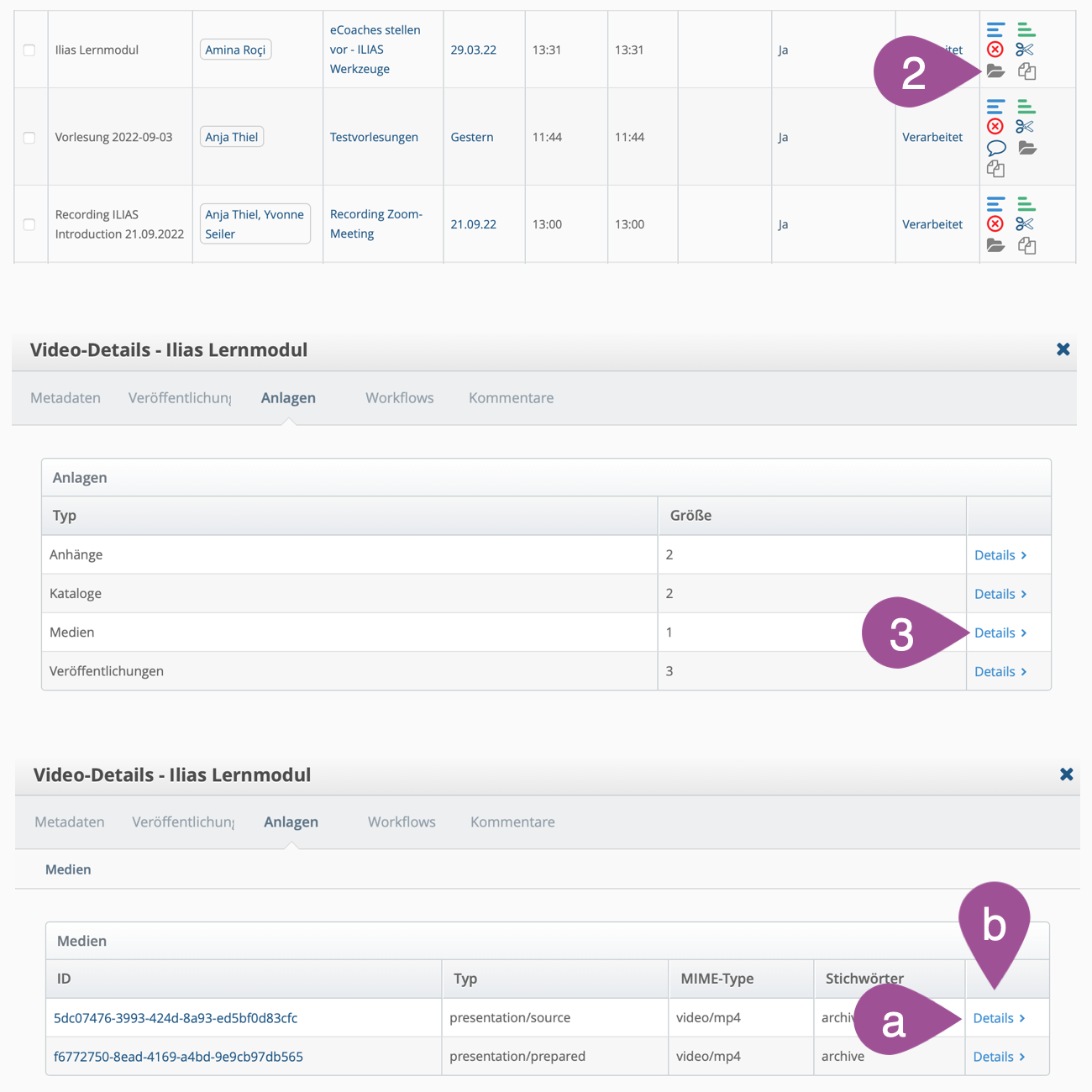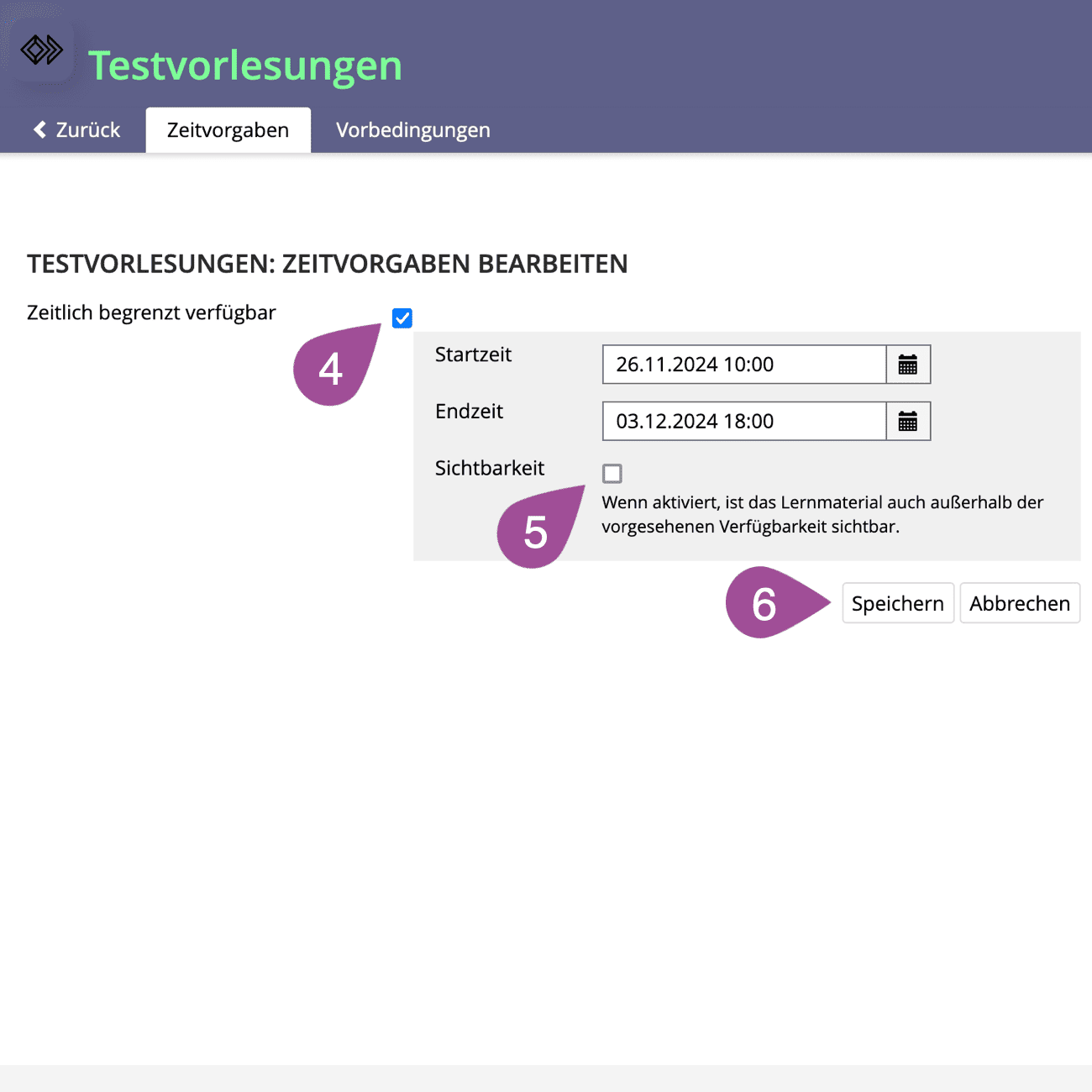ILIAS Support (English)
Reiter
Manual: Opencast Series
Deutsch | English
Manual: Opencast Series
This manual informs about the functions and setting options of the video tool «Opencast Series». For information about the podcast and live streaming service, please consult the Manual: Podcast & Live Streaming.

1. Create an Opencast Series
2. Upload videos to an Opencast series
3. Rename, trim and edit videos
3.1 The video editor from Opencast
3.1.1 Trim and edit videos
3.1.2 Edit tracks
3.1.3 Add or edit subtitles
3.1.4 Select or upload thumbnail
4.1 Create categories with labels (for structured annotations)
4.2 Insert annotations
4.3 Select, edit, comment and share annotations
4.4 Export annotations (for lecturers only)
5. Manage permissions for videos (iVT mode)
5.1 Define and change owner
5.2 Manage access rights
5.3 Create permission groups
6. Find your own Opencast videos and access the View Statistics
6.1. Find your own Opencast videos
6.2. Access and export the View Statistics
.
1. Create an Opencast Series
Click on «Add New Item». | |||||
Select «Video (Opencast Series)». | |||||
You have the choice of opening a new series or incorporating an existing series into your course.
| |||||
Decide under what conditions you want to allow sharing of your video. | |||||
If checked, the series will be visible to course members. You can also set the series online later in the «Settings» tab. | |||||
If necessary, enter working instructions. | |||||
You can also choose to have published recordings automatically posted on the university's video portal Tobira. There are three authorization levels to choose from:
You can find the direct link to the series on Tobira in the «Info» tab at the very top under «Link to Series in Tobira». | |||||
Allows participants to attach private or public time-anchored notes (e.g., theory references, transcription, own reflections, etc.) to the published video (see 4. Annotate videos). | |||||
When checked, videos can only be viewed online and cannot be downloaded. | |||||
Activate this checkbox if you want to set individual permissions per video (see 5. Manage permissions for videos (iVT mode)). | |||||
«Save» your settings. |
In the «Settings» tab, you can view and edit the properties described above.
.
2. Upload videos to an Opencast series
In your series's «Content» tab, click the «Upload Event» button. A new upload window will open. | |
You can eather drag and drop the video you want into the shaded box or click the box and select the desired video. | |
Give the video a suitable title, preferably including the semester and, if applicable, the course title. This makes it easier for students to find the videos again. If necessary, you can specify additional metadata. | |
If you already have one or more subtitle files, you can upload them here. The uploaded subtitles will be added to the video. Supported file types are .text and .vtt | |
You can have subtitles created automatically. During the initial processing of the video, the open source AI application "Whisper" automatically generates subtitles. They can be edited at a later date and corrected if necessary. The automatically recognized subtitles are generally very good and show low word error rates. The open source AI application “Whisper” is operated on our own servers. Like the videos, the subtitles are also processed and stored on the university's servers. | |
Please leave this checkbox checked so that the video is automatically published after it is uploaded and can be viewed by students. If you deactivate the checkbox, you still have to publish the video after uploading it. For later publication, click on the «Start Workflow» button under «Actions» for the video that has not yet been published and then publish the video via the «Direkt publizieren» option. Click «Save». | |
Clicking on «Save» will start the upload of your video. If the video is not displayed immediately after the upload confirmation, please refresh the screen by clicking «Reload Events». It is not necessary to upload the video again. |
Your video will now be uploaded to the Opencast servers and converted - the status «Converting, not yet visible to students». Depending on the video size, uploading and converting can take 30-60 minutes.
.
3. Rename, trim and edit videos
Using Opencast's video editor, you can rename, edit, and trim uploaded videos. Videos that have not been published yet are marked with a corresponding note.
Via «Actions» > «Cut» and subsequent authentication via Campus Account, you are directed to the video editor of the video you want to edit (see The Opencast video editor). In the editor, you can cut the video and publish it afterward. | |
Via «Actions» > «Set online/offline» you can change the online or offline status of an individual recording. Videos and recordings you do not want to cover until later in the course can be hidden (offline) with this function. | |
Via «Actions» > «Edit Metadata» you can change the video title and enter further information about the recording (e.g., date, instructor). These serve as orientation and are displayed in ILIAS next to the preview image. | |
If you do not want to edit the recording, you can «publish directly» the recording with or without automatically generated subtitles via «Actions» > «Start Workflow» > «Direkt publizieren». In this menu item, you can also «copy recording» (= Aufzeichnung kopieren) or «withdraw publication» (= Publikation zurückziehen). |
.
The Opencast video editor
Opencast automatically cuts your lecture recordings during the initial upload and suggests cut marks based on the audio track. Check these suggestions carefully. If necessary, you can remove the cut segments (see point 5 below) or move the cut marks to the left or right in the timeline using drag and drop. Please feel free to send us feedback on this feature.
podcast@id.unibe.ch
.
Trim & edit videos
The audio deflections in the time track of the video make it easier to find segments with or without sound. | |
Use the «Zoom» function to zoom into the time track and edit the video more precisely. | |
To cut, drag the cursor to the desired position. | |
Use the «Cut» button to divide the recording into segments. | |
Use the «Delete» button to mark the segments that should not be published. They are now highlighted in red because they are still awailable but they will not appear in the published recording. If the cursor is in a red segment, the button changes to «Restore» and you can restore the segment. | |
Deactivate the «Preview Mode» if you want to view the red segments too. | |
If requidred, you can use the navigation aid on the left to edit the metadata, tracks, subtitles and the preview image of the video. | |
The «Finish» button gives you the option of publishing the edited video («Save and process changes») or «Save changes». In both cases, you must confirm your selection again (e.g. via «Start processing»). You can close the confirmation page that opens. |
.
Edit tracks
If you want to remove an image or audio track from your video (e.g. for dual-stream recordings or to publish only audio), switch to the «Tracks» area. | |
First activate the «Customize track selection» option. | |
You can now activate/deactivate the desired image or audio tracks by clicking the corresponding checkbox. |
.
Add or edit subtitles
In the subtitles area, you can edit the existing subtitles (e.g. the automatically generated ones), create your own subtitles or upload them. | |
If your video already has existing subtitles, you can edit them by clicking on the corresponding tile. | |
Click on the + sign if you want to add or upload new subtitles. First select one of the supported languages. | |
You can upload new subtitles and download existing subtitles. | |
You can use the + sign to add a new segment before or after an existing subtitle segment. | |
Here you can enter or edit the text. If you click in one of the boxes, the video jumps to the corresponding position. | |
You can change the time and duration of the subtitle segments via the input fields or via the subtitle track. In the track, you can move the segments or shorten or lengthen them by dragging at the beginning and end. | |
The subtitles must be actively published. In the «Finish» area, you decide whether you want to publish the video with or without subtitles. |
.
Select or upload thumbnail
In the «Thumbnail» area, you can generate a preview image from your video or upload your own image. | |
If you want to select an image as thumbnail from the video, position the cursor at the desired location and click «Generate». | |
Alternatively, you can also upload your own thumbnail via «Upload». If possible, it should be in 16:9 format. |
.
4. Annotate videos
If the «Activate Annotations» option is enabled in the «Settings» (see 1. Create an Opencast Series), the annotation tool is activated, which allows you to annotate your videos.
You can access the annotation tool in your ILIAS course through the «Opencast Series». Clicking on the «Annotate» button starts the annotation tool.
|
.
Create categories with labels (for structured annotations)
Using categories (also called structured annotations), it is possible to add labels provided by lecturers to a video. This enables a structured (e.g., criteria- or theory-based) review or evaluation of videos.
In the «Öffentlich» (only for admins) or «Meine» (for all users) tab, click on the triangle select «Kategorie erstellen». Public categories and labels can only be created by lecturers. Students can only create categories with labels in the private area («Meine» tab) or use the categories and labels provided by the lecturers in the public area («Öffentlich» tab) for annotating. | |
You can export (and re-import) your categories. | |
Once created, you can edit categories using the triangle next to the category title and selecting «Kategorie bearbeiten». | |
In the «Neue Kategorie» (or «Kategorie bearbeiten») window, you can set the category's title and color. | |
Specify whether a category refers only to the current video («Gehört zum Video») or to all videos in the series («Gehört zur Serie»). | |
Under «Zugriff», you specify with whom you want to share the created category (only possible for categories in the «Meine» tab). | |
You define the values of the category in the «Labels» section. Define the abbreviations that should be visible in preview mode («+» and «-» in the screenshot). Choose strings that are as self-explanatory or descriptive as possible. | |
If needed, you can additionally assign scales to your categories, which allow you to set additional values to your annotations (example: + to ++++). You can also create scales via the triangle next to the «Öffentlich» or «Meine» tab and selecting «Skala erstellen». | |
«Save» your settings. |
.
Insert annotations
You can insert two types of annotations: Structured annotations for structured review and free text annotations for comments or reflections in your own words. Inserted annotations are automatically saved and will be displayed again when you open the same video in the annotation tool later on.
Video anhalten: Select an option to pause the video. With the «Während des Schreibens einer Freitextannotation» option, the video stops as soon as you start typing. Hitting «Enter» or the «Einfügen» button continues the video and inserts the annotation. Use «Shift + Enter» for a line break. | |
Structured annotations (categories with labels): Clicking one of the buttons inserts the corresponding label into the annotation track and into the list of added annotations. | |
Hide/show selected annotations: You can hide all free text annotations or structured annotations of a category using the eye buttons. |
.
Select, edit, comment and share annotations
Select: | |||||||
You can access annotations via the list or the track. When you double-click, the video skips to and displays the corresponding position in the viewer. You can expand an annotation via the triangle. | |||||||
You can edit annotations using the pencil icon. | |||||||
You can change the duration of the annotations by moving the cursor on the annotation track and clicking the corresponding buttons («START» / «SCHLUSS») or by entering the exact times in the corresponding fields. | |||||||
Clicking on the speech bubble opens the comment field. The comments are saved with the creation date and author. | |||||||
Annotations are initially private and cannot be viewed by others. You can change access to your annotation track by clicking on the padlock or the Pencil icon.
| |||||||
Shared annotations of other people can be shown and hidden via the «Spuren verwalten» button. | |||||||
The «+ Spur hinzufügen» button adds additional annotation tracks. |
.
Export annotations (for lecturers only)
.
5. Manage permissions for videos (iVT mode)
The iVT mode (= individual video training mode) of the «Opencast Series» utilizes individual permission management. There are three different ways to grant access rights to students: Owner (see 5.1 Define and change owner
), access rights (see 5.2 Manage access rights) and permission groups (see 5.3 Create permission groups). This allows you to decide for each video whether only a single person or a group of people can access the video. If students are filmed while completing an assignment, this preserves their privacy rights.
To activate iVT mode and be able to define person-specific access to each video, the settings of the «Opencast Serie» must be set accordingly:
In your «Opencast Series», go to the «Settings» tab. | |
Activate the «Set permissions per Event» function. | |
Enable this option if you want the owners themselves to determine who can view their videos (grant access rights). | |
«Save» your settings. |

.
Define and change owner
Owners can view their own video and (if enabled) grant other users access rights to their own video (see 5.2 Manage access rights). To change the owner of a video, follow the steps below:
Open the video's «Actions» menu. | |||||
Select «Edit Owner». | |||||
To define a new owner, you must first delete the current owner in the «Owner» column. | |||||
Under «Available Participants», you can select a new owner.
|
.
Manage access rights
Series administrators, owners, and group members of the owner (see 5.3 Create permission groups) can access the video regardless of granted access rights. To give additional people access rights, video owners and administrators can follow the steps below:
Open the video's «Actions» menu. | |||||||
Select «Grant access rights». | |||||||
Video owners and series administrators can grant access rights under «Available Participants».
| |||||||
In the column «Grant Access to Event», all persons granted access to the video manually are listed. Here you can revoke access rights. |
.
Create permission groups
Using the group function, you can define group-based access permissions. Group members will then have access to the videos of all members of their permission group.
Go to the «Groups» tab in your «Opencast Series». | |||||
Enter a group name and click «Create». | |||||
Select the appropriate group to add members to.
| |||||
In the column «Members», all group members are listed. Here you can remove people from the group. | |||||
To delete a group, select the group and click the cross symbol. |
.
6. Find your own Opencast videos and access the View Statistics
The quickest way to get an overview of your podcasts and videos is to use the video server https://opencast.unibe.ch. All podcasts and videos uploaded to an «Opencast Series» via ILIAS are stored on this server. The View Statistics can also be accessed and exported here.
.
Find your own Opencast videos
Go to the website https://opencast.unibe.ch. Log in with your Edu-ID. If you do not yet have access rights in Opencast, you will need to request them using the form that pops up. The podcast support team will grant you these rights as soon as possible. Once you have the necessary rights, an overview table will be displayed. | |
Sort table: Click on a column header to sort the table (ascending or descending). Example: If you want to have your oldest recording on top, click once or twice on the column «Date». | |
Check publication status: If you see a «Yes» in the «Published» column, the recording is published. If the recording is not published, the field is empty. | |
If you want to see all videos in a series, click on the title of the relevant series in the «Series» column. This adds a filter (noticeable in the upper right corner, in the example: «eCoaches stellen vor - ILIAS Werkzeuge»). If you want to return to seeing all your videos, delete this filter. |
.
Access and export the View statistics
On the Opencast video server, you can view View statistics for both single events and video series. The statistics can be exported as a .csv file. The available dates back to November 2023.
Go to https://opencast.unibe.ch. and log in with your Edu-ID. If you do not yet have access rights in Opencast, you will need to request them using the form that pops up. The podcast support team will grant you these rights as soon as possible. Once you have the necessary rights, an overview table will be displayed. | |
Select the desired view at the top left: «Events» or «Series». All your videos or series will be displayed. Click on the title of a series to display all the videos in this series. | |
Find the video or series you're looking for and click on the blue icon (video details) or the green icon (series details) in the «Actions» column. | |
A window will open with the video or series details. Switch to the «Actions» tab. | |
Select the desired display mode. Three options are available: «Year», «Month», «Custom». Under «Custom», you can specify a time period and refine the display details («Yearly», «Monthly», «Daily», «Hourly»). | |
You can download the raw data of the displayed statistics as a .csv file by clicking on the blue download icon. |
Please note that we cannot guarantee 100% accuracy of the statistics. For example, no statistical data is collected if the "Do Not Track" setting is activated in browsers. Based on experience, this can lead to accuracy deviations of up to 20%. With low access figures, these deviations can also be higher.
- Number of live stream views and video views in ILIAS Opencast series
- Downloads in ILIAS Opencast series
- Number of video and livestream views in Tobira
.
7. Download videos
The easiest way to download published videos is via ILIAS and the corresponding «Opencast Series» in ILIAS. If you can't find this series in ILIAS or your videos are not published, you can also download the videos directly in Opencast (see 7.2 Download via Opencast). Downloading via Opencast is much more cumbersome and will download the original recording (including any parts that have been cut out).
Notes on videos published on the video platforms Tobira or SWITCHtube
Tobira
* If videos are published both in ILIAS and on Tobira, the easiest way is to download them via ILIAS (see 7.1 Download via ILIAS).
* If the Opencast videos are only published in Tobira (and not in ILIAS), you can download the raw recordings from opencast.unibe.ch (see 7.2 Download via Opencast).
SWITCHtube
* Videos uploaded directly to SWITCHtube must be downloaded directly from tube.switch.ch. You can activate the download option in the video series' settings.
https://tobira.unibe.ch
https://tube.switch.ch
https://opencast.unibe.ch
.
Download via ILIAS
Download via ILIAS is only possible for published videos. Follow the steps below:
Log in to ILIAS. Open the relevant «Opencast Series» in ILIAS and go to the «Settings» tab. | |
Make sure that the «No Download» option is not checked. | |
Click on «Save». | |
Go to the «Content» tab. | |
Click «Download» on the video you like to download, and select the video quality you want. The higher the value before the «p», the higher the video quality and the larger the file size. Depending on your browser settings, the file will either be downloaded directly, or a window will open where you can select the download location. |
.
Download via Opencast
Download via Opencast is possible for all videos, including non-published videos. Follow the steps below:
Go to the website https://opencast.unibe.ch. Log in with your Edu-ID. If you do not yet have access rights in Opencast, you need to request them using the form that pops up. The podcast support team will give you these rights as soon as possible. Once you have the necessary rights, you will see an overview table. | |||||
Click the folder icon on the far right of the video you want to download. The «Event details» open in the «Assets» tab. | |||||
In the «Media» row, click «Details» on the far right. You will now see the table with the title «Media». The next steps depend on whether you want to download regular videos and podcasts or podcasts with two image sources.
| |||||
At the very bottom, you can see a «Preview» of the video. | |||||
To download this video, click the URL address ending in a video format abbreviation (here .mp4) in the «URL» row. Depending on your browser settings, the file will either be downloaded directly, or a window will open where you can select the download location. |
.
8. Restrict availability
You can set the period in which the Opencast Series can be accessed. Outside this period, the Opencast Series cannot be accessed.
Go to the location on ILIAS where you have stored the Opencast Series. | |
Open the series' actions menu. | |
Select «Availability». | |
Activate the «Temporarily available» option and enter the period during which you want the Opencast Series to be accessible. | |
If checked, the Opencast Series is visible outside the designated availability but cannot be accessed. | |
«Save» your settings. |
.
9. Application scenarios
The following pages will give you an idea of how an Opencast Series can be used:
Zuletzt geändert: 5. Sep 2025, 09:46, Thiel, Anja [a.thiel5]













